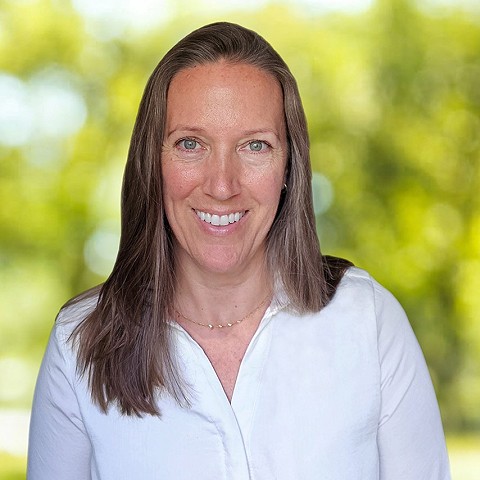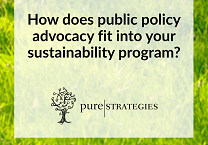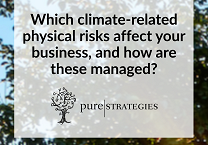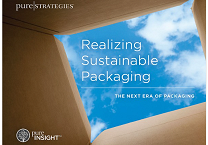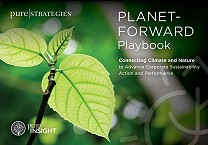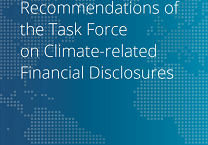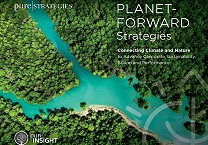Green Eggs and Ham: Sustainability Pillars for Animal-Based Food Production
by Cheryl Baldwin, PH.D.
26 February 2013
(With apologies to Dr. Seuss on his birthday)
Do you like green eggs and ham?
What makes them green, Sam-I-am?
Do they come from a cage?
From indoor pens or from free-range?
What did they eat at hunger’s peak?
Were droppings left to pollute my creek?
Were they fed an antibiotic?
Or the toxic metal arsenic?
Did they come from across the sea?
Or did they come from nearby me?
It’s not so easy, as you can see,
To know what green eggs and ham can be.
There are many questions that go into understanding “green” eggs and ham, as the Dr. Seuss-inspired poem above suggests. Asking questions about environmental, social, and economic impact is a typical starting point for advancing product sustainability. For animal-based food products, sustainability also needs to address the animal’s care. The top animal welfare issues companies are tackling concern cages for egg-laying hens and gestation crates for sows. But does addressing these animal welfare issues make for green eggs and ham?
There is general agreement that responsible animal care addresses at least the following five freedoms:
- Freedom from hunger or thirst by ready access to fresh water and a diet to maintain full health and vigor.
- Freedom from discomfort by providing an appropriate environment including shelter and a comfortable resting area.
- Freedom from pain, injury or disease by prevention or rapid diagnosis and treatment.
- Freedom to express normal behavior by providing sufficient space, proper facilities and company of the animal's own kind.
- Freedom from fear and distress by ensuring conditions and treatment that avoid mental suffering.
Hen cages and sow crates are the most commonly used housing for the animals, but these enclosures can be so small that they limit the animals’ abilities to express normal behaviors like walking or turning around, one of the five freedoms. Animal housing with more space may have issues with other freedoms, like discomfort when housed outside in extreme temperatures or risk of injury when housed with other animals. Finding the green solution for animal care begins by effectively addressing each of the five freedoms.
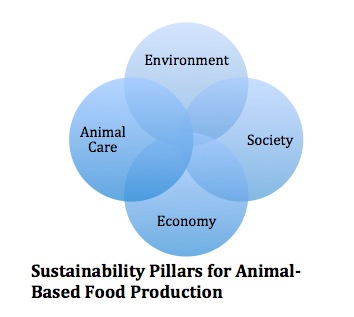 Addressing the five freedoms does not necessarily get to all of the health and welfare considerations in today’s production systems. Management issues also require attention. For example, there are questions about the appropriate use of antibiotics and other feed additives such as arsenic. Both of these potentially harmful additives are used to reduce infections typically caused from underlying care issues of poor sanitation or overcrowding where germs spread easily and to improve the animal’s productivity and profitability (e.g., sub-therapeutic antibiotic use in feed). While antibiotics are needed for therapeutic uses, these other conditions have contributed to agriculture accounting for 70% of antibiotics sold in the U.S. – with the pork industry emerging as one of the heaviest users, especially of antibiotics used to treat humans.[1] Recent data from the U.S. Food and Drug Administration show that the use of antibiotics for meat and poultry production has reached record levels, and is increasing (take a look at this infographic from Pew Charitable Trusts).
Addressing the five freedoms does not necessarily get to all of the health and welfare considerations in today’s production systems. Management issues also require attention. For example, there are questions about the appropriate use of antibiotics and other feed additives such as arsenic. Both of these potentially harmful additives are used to reduce infections typically caused from underlying care issues of poor sanitation or overcrowding where germs spread easily and to improve the animal’s productivity and profitability (e.g., sub-therapeutic antibiotic use in feed). While antibiotics are needed for therapeutic uses, these other conditions have contributed to agriculture accounting for 70% of antibiotics sold in the U.S. – with the pork industry emerging as one of the heaviest users, especially of antibiotics used to treat humans.[1] Recent data from the U.S. Food and Drug Administration show that the use of antibiotics for meat and poultry production has reached record levels, and is increasing (take a look at this infographic from Pew Charitable Trusts).
Development of antibiotic resistant microorganisms and less-effective medicines have been the leading concerns with the high levels of antibiotic use in agriculture. An extreme situation appears to be unfolding in China where antibiotic use for pork production is very high and rapidly creating antibiotic resistance. Two classes of antibiotics that are commonly used in livestock and poultry are of medical importance to humans, penicillins and tetracyclines. As a result, the World Economic Forum and the World Health Organization have called for reduced use of such antibiotics in agriculture to help minimize the potential that the medicines needed for people become ineffective. Good management with proper sanitation and husbandry practices that keep the animals well-nourished and healthy (e.g., environment, weaning practices), in combination with addressing the five freedoms, can help address this issue.
What are green eggs and ham? Addressing animal care, including both welfare and management considerations, as a pillar in the sustainability framework of environment, society, and economy provides the path toward answering the question.
Inspiration for this blog came from the fun and insightful books written by Dr. Seuss. Celebrate the brilliance of Dr. Seuss on his birthday, March 2 - read one, or two, or three of his books!
Written by Cheryl Baldwin, PH.D.
Cheryl Baldwin, Ph.D., is a Vice President of Sustainability Consulting for Pure Strategies where she partners with corporate clients to develop and execute sustainability strategies to improve performance across retail, food and agriculture, home and personal care, and cosmetics industries. She also leads the firms’ global market research to generate new insights to accelerate business transformation.
Cheryl’s recent projects include helping build a leading nature strategy for Toyota Motor North America, developing sustainability goals for TAZO, creating a sustainable packaging strategy and implementation tools for Walmart, and advancing a sustainable chemistry program for Sephora. Cheryl also worked with industry groups to support broader impact including, FMI, the food industry association, and the National Retail Federation (NRF).
Cheryl authored Pure Strategies’ market research reports: Planet-Forward Strategies, Connecting to the Farm, Reaching the New Corporate Frontier, Advancing on the Path to Product Sustainability, and other reports. She wrote the book, The 10 Principles of Food Industry Sustainability and is the lead author/editor for two additional books on sustainability, Greening Food and Beverage Services and Sustainability in the Food Industry and holds U.S. and international patents.
Prior to Pure Strategies, Cheryl led the life cycle research and sustainability standard program for the non-profit ecolabel organization Green Seal. Cheryl also worked in Research and Development for Kraft Foods, Inc. where she was involved in all phases of R&D from novel ingredient development to global product commercialization. Cheryl holds a Ph.D. and M.S. from Cornell University and a B.S. from the University of Illinois, all in Food Science.
Cheryl has been named one of the Top 50 Women Leaders of DC for the second consecutive year, based on a methodical review of women executives and leaders across the area. She was identified for her career track record, including her leadership position at Pure Strategies. The recognition came from Women We Admire (WWA), a membership organization of over 1,200 of the most accomplished women leaders in business, law, consulting, education, non-profit and other sectors. based on a methodical review of women executives and leaders across the area. She was identified for her career track record, including her leadership position at Pure Strategies. The recognition came from Women We Admire (WWA), a membership organization of over 1,200 of the most accomplished women leaders in business, law, consulting, education, non-profit and other sectors.


